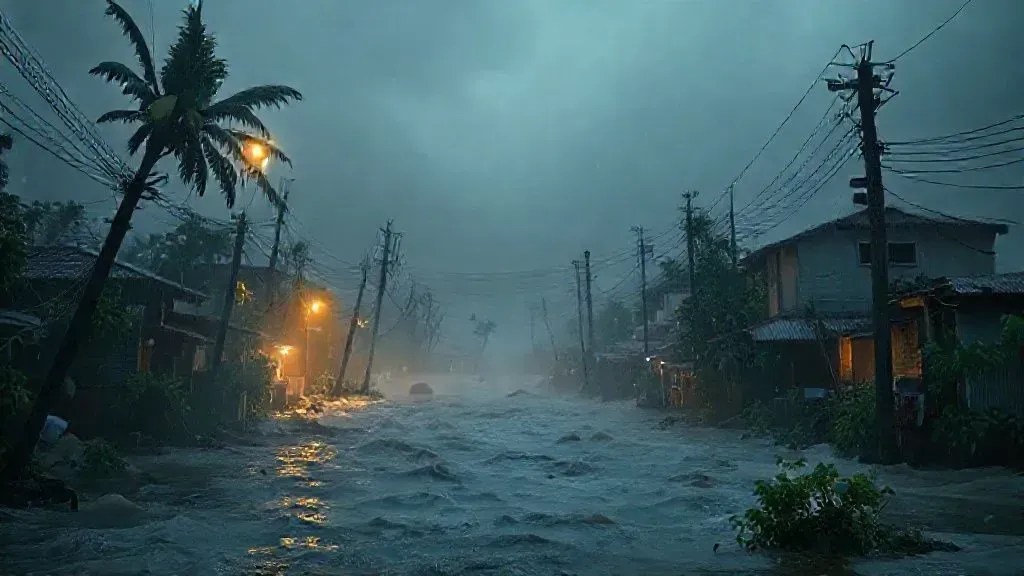
Over 1.4 million people faced displacement from Super Typhoon Fung-wong in the Philippines during November 2025. This storm followed Typhoon Kalmaegi, which had already killed nearly 200 individuals. Authorities noted Fung-wong's size nearly matched the country's landmass, amplifying its destructive reach.
The Storm's Path and Intensity
Super Typhoon Fung-wong, locally called Uwan, intensified rapidly before landfall on Luzon. It packed sustained winds up to 185 km/h with gusts exceeding 230 km/h.
The typhoon triggered torrential rains and storm surges in eastern and northern regions. Rescue operations halted temporarily due to extreme conditions.
According to Reuters, over 100,000 residents evacuated from high-risk areas as winds battered infrastructure. This proactive measure likely saved numerous lives.
Immediate Devastation: Floods and Landslides
Floods submerged entire towns, cutting off access and causing widespread power outages. Landslides buried homes in volcanic ash in some areas.
The storm knocked out electricity in whole provinces, complicating recovery efforts. Officials declared a state of national emergency.
Devastating footage captured the storm surge in Tambognon, Viga, Catanduanes, highlighting the surge's destructive force.
Human Toll and Casualties
At least eight people died, including children, from floods and landslides. Thousands sought shelter in evacuation centers.
Reports from the Associated Press detailed how the typhoon exited the northwest after its rampage. Displaced families now rebuild amid ongoing threats.
Hans Kluge, WHO Regional Director, stated he felt deeply saddened by Fung-wong's impact following Kalmaegi. He praised health workers' dedication in these emergencies.
June Kunugi from UNICEF expressed heartbreak over storms upending children's lives in the region. She highlighted disruptions to education and futures.
Government Response and Evacuations
The Philippine government coordinated mass evacuations, moving over a million to safety. This reduced potential casualties significantly.
Emergency shelters provided food, water, and medical aid to those affected. Logistical challenges delayed some relief in remote areas.
A personal account from a local trader described the typhoon as a monster storm after a recent earthquake. He called for prayers amid recovery.
International Aid and Challenges
International organizations mobilized resources quickly to support relief. The US, UK, and Germany sent aid and specialists.
Critics pointed to underfunded disaster infrastructure straining from back-to-back storms. Environmental groups linked increased typhoon severity to climate change.
According to CBS News, Fung-wong slammed Luzon as a super typhoon, causing power outages and displacing 1.4 million. It emphasized the need for stronger mitigation policies.
Humanitarian warnings noted repeated disasters stretching resources thin. Long-term displacement raises concerns over recovery plans.
Economic and Infrastructure Damage
The typhoon destroyed about a thousand houses and cut power to provinces. Flights canceled and towns isolated by landslides.
Widespread damage hampered livelihoods, with officials assessing the full scale. Recovery focuses on rebuilding resilient infrastructure.
PBS News reported eight deaths and 1.4 million displaced from floods and landslides. It underscored the urgency of addressing vulnerabilities.
Long-Term Implications for Resilience
Frequent storms highlight the need for enhanced preparedness and early warning systems. These measures proved effective in limiting deaths.
Building greater resilience against climate-driven events remains crucial for the Philippines. Investments in adaptation could mitigate future impacts.
This article underscores the profound effects of natural disasters on vulnerable populations. It emphasizes the value of timely information and global solidarity in fostering recovery and prevention strategies.


